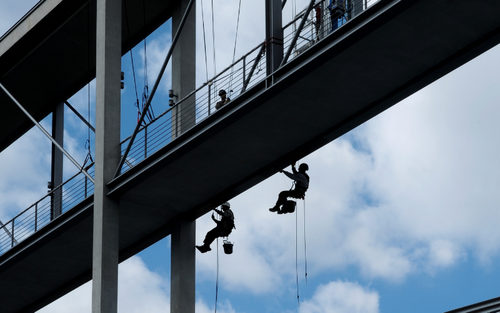What Are the Risks of Leading and Sharp Edge Situations In Fall Protection?
Being far above the ground is a hazard all on its own, but it’s not the only hazard that comes with elevated work. Sharp and leading edges are some of the biggest hazards that can affect fall protection. Sharp edges are edges that aren’t completely rounded and have the potential to completely sever most lifelines. A leading edge is any situation where a worker is exposed to a potential fall over the edge of a work surface.
Both types of edges present their own hazards, and a worksite could likely combine those hazards — a leading edge can also be a sharp edge. Thankfully, many organizations are incorporating leading or sharp edge criteria into their standards or working on new solutions. With awareness, training, and the right equipment, you can protect yourself from these common hazards of leading and sharp edge situations.
Damaged Lifelines
One of the biggest risks with a sharp edge is that the lifeline can get damaged. Fraying, cutting, or severing the lifeline can cause a worker to fall to a lower level and get seriously hurt. This is especially true with webbing type lifelines. Most leading edge lifelines incorporate wire rope cable since it will be more resistant to cutting. Learn how to inspect your self-retracting lifeline. If the equipment doesn’t look unarguably safe when you’re inspecting it before work, don’t use it.
Increased Fall Distance
In leading edge situations where workers are attached at foot level, any falls are going to be farther than they would be if the anchor was at shoulder height or directly overhead. When working with a foot-level anchor, use a system specifically designed for leading edges and reference the user instructions for how to calculate fall clearance.
Less SRL Reaction Time
Self-retracting lifelines work by reacting to the velocity of the lifeline accelerating out of its housing. Once it hits a certain speed after a fall, the lifeline locks up to stop the fall. However, with foot-level anchoring like a worker would have in a leading edge situation, the required velocity to engage the fall arrest gear might not even be reached.
Increased Fall Arrest Forces
Whether it’s because the lifeline is severed or because the fall couldn’t be stopped in time, a worker might fall farther. This increases the fall arrest forces as well as their impact on the body. This is why many products for leading or sharp edge situations include additional energy-absorbing hardware.
More Swing Fall Hazards
Dangling from an edge means that a worker could swing back and forth on the end of their lifeline after a fall, especially if they’re off to one side of the anchor point. This is bad enough on its own because of the possibility of hitting other objects, but if the leading edge is also a sharp edge, swinging can lead to the edge sawing through the lifeline, which damages the lifeline and can lead to falls.
PK Safety has been your worksite safety partner for over 70 years. We personally vet the equipment that we sell and while you can find a great deal of information on our site, our factory trained product experts are here to provide more detailed answers about your specific situations and work environments. For more information, contact one of our safety experts by calling 800.829.9580 or use our online contact form.
Recent Posts
-
Customizing Gas Detectors: Tailoring Solutions to Fit Your Unique Requirements
In today’s diverse industrial landscape, a one-size-fits-all approach to safety simply doesn’t cu …Jul 3rd 2024 -
10 Ways to Prevent Wildfires
You can prevent wildfires by extinguishing flames before you leave the worksite. Avoid practicing …Jul 1st 2024 -
ANSI/ISEA 138 Safety Gloves: Ensuring Hand Protection
The human hand is an anatomical masterpiece and arguably the greatest tool attached to our bodies …Jun 25th 2024





